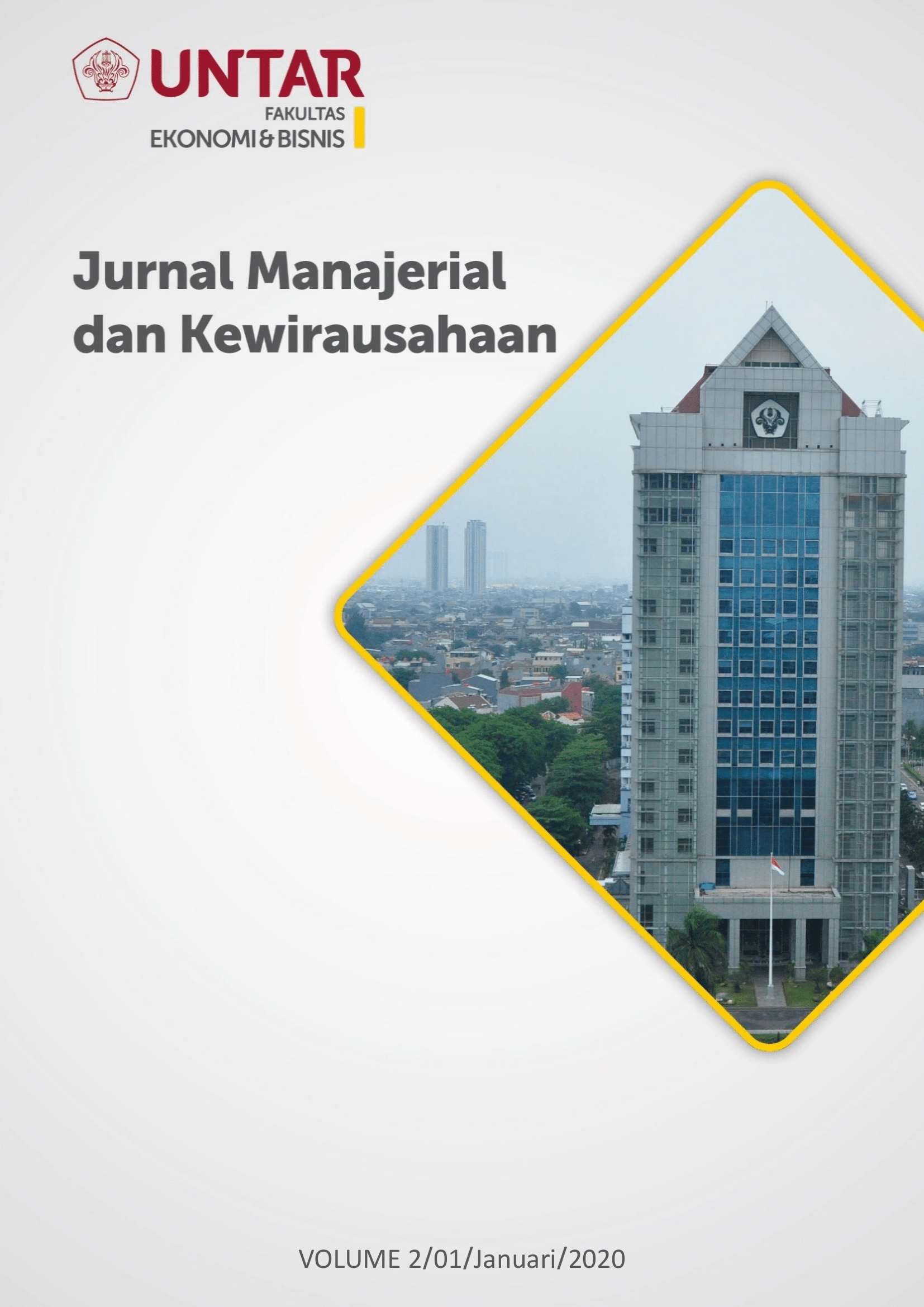Pengaruh Ewom Terhadap Brand Image Dan Purchase Intention Produk Innisfree Di Jakarta
Main Article Content
Abstract
The purpose of this study is to find out 1) whether there is an effect of EWOM on Purchase Intention 2) whether there is an influence of the EWOM on Brand Image 3) whether there is an Influence of Brand Image on Purchase Intention 4) whether Brand Image can meditiate EWOM influence on Purchase Intention. The population in this study were Innisfree products users in Jakarta. The sample used in this study was 100 respondents from Innisfree products users in Jakarta. The sampling technique used was probability sample with simple random sampling method. Overall the results of this study are 1) EWOM has a significant and positive effect on Purchase Intention, 2) EWOM has a significant and positive effect on Brand Image, 3) Brand Image has a significant and positive effect on Purchase Intention 4) Brand Image has significantly and positively meditiate the effect of EWOM on Purchase Intention.
Tujuan penelitian ini adalah untuk mengetahui 1) apakah terdapat pengaruh EWOM terhadap Niat pembelian 2) apakah terdapat pengaruh EWOM terhadap Citra Merek 3) apakah terdapat pengaruh Citra Merek terhadap Niat pembelian 4) apakah terdapat pengaruh EWOM terhadap Niat Pembelian melalui mediasi Citra Merek. Populasi dalam penelitian ini adalah pengguna Produk Innisfree di Jakarta. Sampel yang digunakan pada penelitian ini yaitu 100 responden pengguna produk Innisfree di Jakarta. Teknik pengambilan sampel yang digunakan yaitu probability sampling dengan metode pengambilan sampel simple random sampling. Secara keseluruhan hasil dari penelitian ini yaitu 1) EWOM berpengaruh signifikan dan positif terhadap Niat Pembelian 2) EWOM berpengaruh signifikan dan positif terhadap Citra Merek, 3) Citra Merek berpengaruh signifikan dan positif terhadap Niat Pembelian 4) Citra Merek secara signifikan dan positif memediasi pengaruh EWOM terhadap Niat Pembelian.
Article Details
This work is licensed under a Jurnal Muara Ilmu Ekonomi dan Bisnis Creative Commons Attribution-ShareAlike 4.0 International License.,/p>
References
Alsa, A. (2003). Pendekatan Kuantitatif dan Kualitatif Serta Kombinasinya dalam Penelitian Psikologi. Yogyakarta: Pustaka Pelajar.
Aritonang, R., & Lerbin, R. (1998). Penelitian pemasaran. UPT Penerbitan Universitas Tarumanagara. Jakarta.
Aritonang, R., & Lerbin, R. (2007). Riset Pemasaran: Teori dan Praktik. Bogor: Ghalia Indonesia.
Cheung, C. M. K., Lee, M. K. O., & Rabjohn, N. (2008). The impact of electronic word of mouth: the adoption of online opinions in online customer communities. Internet Research, 18(3), 229-247. doi.org/10.1108/10662240810883290.
Cheung, M. Y., Luo, C., Sia, C. L., & Chen, H. (2009). Credibility of electronic word of mouth: informational and normative determinants of on-line consumer recommendations. International Journal of Electronic Commerce, 13(4), 9-38. http://doi.org/10.2753/JEC1086-4415130402.
Chu, S. C., & Kim, Y. (2011). Determinants of consumer engagement in electronic word-of-mouth (eWOM) in social networking sites. International Journal of Advertising, 30(1), 47-75. doi.org/10.2501/IJA-30-1-047-075.
De Cannicre, M. H., De Pelsmacker, P., & Geuens, M. (2009). Relationship quality and the theory of planned behavior models of behavioral intentions and purchase behavior. Journal of Business Research, 62(1), 82-92. http://doi.org/10.1016/j.jbusres.2008.01.001.
Erkan, I. (2016). The influence of electronic word of mouth in social media on consumers’ purchase intentions. Doctoral dissertation, London. Brunel University.
Foxall, G. R. (2005). Understanding consumer choice. Basingstoke: Palgrave Macmillan. http://doi.org/10.1057/9780230510029.
Gadermann, A. M., Guhn, M., & Zumbo, B. D. (2012). Estimating ordinal reliability for Likert-type and ordinal item response data: a conceptual, empirical, and practical guide. Practical Assessment, Research & Evaluation, 17(3).
Hennig-Thurau, T., Gwinner, K. P., Walsh, G. and Gremler, D. D. (2004), Electronic word-of-mouth via consumer-opinion platforms: what motivates consumers to articulate themselves on the internet? Journal of Interactive Marketing, 18(1), 38-52.
I. Erkan and C. Evans. (2016). The influence of eWOM in social media on consumers’ purchase intentions: An extended approach to information adoption. Computers in Human Behavior, Vol. 61, 47-55.
Infosino, W. J. (1986). Forecasting new product sales from likelihood of purchase ratings. Marketing Science, 5(4), 372-384. http://doi.org/10.1287/mksc.5.4.372.
J. G. Udo, K. K. Bagchi, and P. J. Kirs. (2010). An assessment of customers’ e-service quality perception, satisfaction and intention. International Journal of Information Management, 30(6), 481-492. http://dx.doi.org/10.1016/j.ijinfomgt.2010.03.005.
Korea Pharmaceutical Traders Association. (2012). Korean Pharmaceutical and cosmetics export statistics, //www.kpta.or.kr/eng/Info/statistics_export.asp Accessed 13/03/2019 at 22:08pm.
?opaciuk, A., & ?oboda, M. (2013). Global beauty industry trends in the 21st century. In Management, knowledge and learning international conference, 19-21.
M. M. M. A. Riffai, K. Grant, and D. Edgar. (2012). Big TAM in Oman: Exploring the promise of online banking, its adoption by customers and challenges of banking in Oman. International Journal of Information Management, Vol. 32 (3), 239-250.
Morrison, D. G. (1979). Purchase intentions and purchase behavior. Journal of Marketing, 43(2), 65-74. http://doi.org/10.2307/1250742.
P. Chatterjee. (2001). Online review: Do consumers use them. Advances in Consumer Research, 28(1), 129-133.
R. Petty and J. Cacioppo. (1983). Communication and Persuasion: Central and Peripheral Routes to Attitude Change. Springer-Verlag: New York.
Shu, M. L., & Scott, N. (2014). Influence of social media on chinese students' choice of an overseas study destination: an information adoption model perspective. Journal of Travel & Tourism Marketing, 31(2), 286-302. http://doi.org/10.1080/10548408.2014.873318.
Special report: Pots of promise - the beauty business. (2003). The Economist, 367, 71. Retrieved from //search.proquest.com/docview/224021454?accountid=4575325/03/2019 at 11:24 pm.
Sugiyono. (2012). Metode Penelitian Kuantitatif Kualitatif dan R&D. Bandung: Alfabeta.
Sugiyono. (2013). Metodologi Penelitian Kuantitatif, Kualitatif Dan R&D. Bandung: Alfabeta. www.innisfree.com/sg/en/BrandPage.do?pageName=brand_history accessed 12/03/2019 (9:16am).
Sun, B., & Morwitz, V. G. (2010). Stated intentions and purchase behavior: a unified model. International Journal of Research in Marketing, 27(4), 356e366. http://doi.org/10.1016/j.ijresmar.2010.06.001.
S. W. Sussman & W. S. Siegel. (2003). Informational influence in organizations: An Integrated approach to knowledge adoption. Information Systems Research, vol. 14(1), 47-65.
Wan, F., Youn, S., and Fang, T. (2001). Passionate Surfers in Image-Driven Consumer Culture: Fashion-Conscious, Appearance-Savvy People and Their Way of Life. Advances in Consumer Research, Vol. 28, 266-274.
Wolny, J., & Mueller, C. (2013). Analysis of fashion consumers' motives to engage in electronic word-of-mouth communication through social media platforms. Journal of Marketing Management, 29(5-6), 562-583. http://doi.org/10.1080/0267257X.2013.778324.



